DreamWorks Animation is best known for the Shrek franchise, which they followed up with Over the Hedge, Madagascar, Flushed Away, and the Bee Movie.
They were the first CGI animation company to release two features in a single year. At any given time they have as many as five films in development. Jeffrey Katzenberg, the “K” in DreamWorks SKG has said, “Walt Disney made movies for the child in every adult. We make movies for the adult in every child.”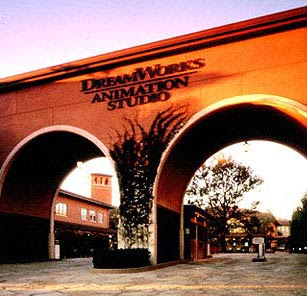
DreamWorks Animation occupies two campuses, one in southern California, and one in the Bay Area of northern California, linked with a high tech video conferencing system. Both campuses have designers, animators and technical wizards, but the architecture and atmosphere of the campuses is quite different.
The southern campus in Glendale is Spanish style, with fountains, goldfish ponds, tile floors, and arched hallways. The northern facility, called PDI DreamWorks, occupies a modern but attractive building overlooking the baylands of Redwood City. We arrived early, and I did a quick watercolor study of the industrial architecture nearby, which I have a fondness for.The studio works hard to create a “culture of mentorship” at both campuses, with free classes offered after hours in life drawing and character design. There’s a hallway space called the “Blue Sky Gallery” where artists can show other facets of their creative life beyond what they do from 9 to 5. Breakfast and lunch are free, and we were told that most new hires gain ten pounds in the first month or two. Free food! I gained five pounds just at lunch!
A huge visual research library (above) is available on campus. Each film takes about four years in the pipeline. “Each project has its own aesthetic,” explained John Tarnoff, head of Outreach, “and it grows out of its story and characters.”
 After my presentation I was honored to meet many of the DreamWorks artists, including Shane Prigmore. He did the sketch above just for fun in a character design class where the assignment was to imagine how Ronald Searle would draw Conan.
After my presentation I was honored to meet many of the DreamWorks artists, including Shane Prigmore. He did the sketch above just for fun in a character design class where the assignment was to imagine how Ronald Searle would draw Conan.
I also met artist Nathan Fowkes (below), whose "color keys" help establish the mood and lighting of the show—in this case Shrek the Halls. Other artists bring a different range of talents to the production process: modeling, rigging, texturing, lighting, and effects. “One of the strengths of our production process,” John Tarnoff said, “is our facial animation system.”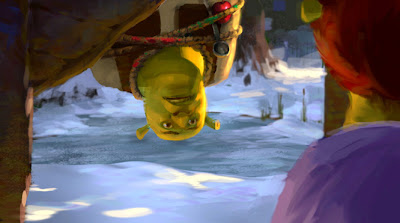 Students who are interested in working at DreamWorks animation might want to keep a couple of things in mind. I asked John Tarnoff what skill sets are not always covered in art schools. “Any visual designer who wants to be in this business,” he said, “needs to know what writing is about: motivation, characterization, and plot. The zeitgeist of this company is that we’re all storytellers.”
Students who are interested in working at DreamWorks animation might want to keep a couple of things in mind. I asked John Tarnoff what skill sets are not always covered in art schools. “Any visual designer who wants to be in this business,” he said, “needs to know what writing is about: motivation, characterization, and plot. The zeitgeist of this company is that we’re all storytellers.”Jim Conrads, my host in the northern California studio answered the same question differently. He felt that artists need to develop the social skills: teamwork, compromise, and respect for others’ points of view. “Artists are usually taught to come up with their own personal expression,” he said, “but rarely encouraged to carry out another’s vision or blend with another’s style.” Below: The Redwood City campus of PDI DreamWorks.
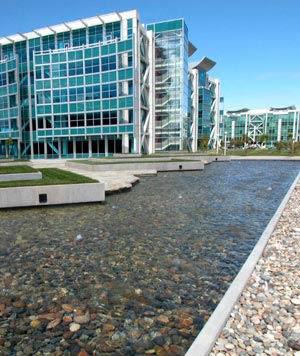 And the portfolio you present should go beyond the common cliches of fantasy art. Kathy Altieri, head of Show Development, told me that she gives a presentation at art schools called “Chicks and Guns,” to make the point that you need to show a lot more than sexy girls and weapons. Your portfolio will stand out if you can draw all kinds of architecture, costumes, animals, and characters.
And the portfolio you present should go beyond the common cliches of fantasy art. Kathy Altieri, head of Show Development, told me that she gives a presentation at art schools called “Chicks and Guns,” to make the point that you need to show a lot more than sexy girls and weapons. Your portfolio will stand out if you can draw all kinds of architecture, costumes, animals, and characters.Thanks to everyone at both campuses, and best wishes on your ongoing projects.
Some photos of facilities courtesy DreamWorks.
Viewing: Blog Posts Tagged with: seven to be exact., Most Recent at Top [Help]
Results 1 - 5 of 5
Blog: Gurney Journey (Login to Add to MyJacketFlap)
JacketFlap tags: road tour, Movie Studios, Add a tag
Blog: Gurney Journey (Login to Add to MyJacketFlap)
JacketFlap tags: road tour, Movie Studios, Add a tag
Creating lifelike digital animals is one of the greatest challenges for CGI artists. We’ve all seen film footage of real penguins, pigs and polar bears, so our eyes can instantly recognize anything that doesn’t ring true. That makes the accomplishments of the team at Rhythm and Hues all the more remarkable.
That makes the accomplishments of the team at Rhythm and Hues all the more remarkable.
Founded by John Hughes and Pauline Ts’o (below, left), they created award-winning special effects for films like Golden Compass, Night at the Museum, Narnia, Charlotte’s Web, and Babe. Rhythm and Hues is a complete digital studio, with not only post-production FX, but also CG animation (such as Happy Feet), and a range of design services.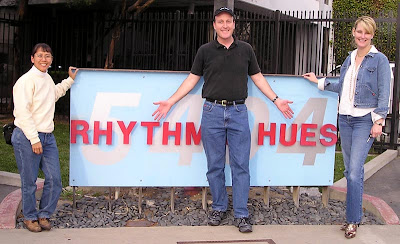 We toured the campus, housed in a 70,000 square foot building in west LA, just north of the airport. The facility includes a sound stage, screening room, work areas for the animators, and conference rooms, all brimming over with works in progress. In the center of the building is a light-filled open stairway that serves as a mixing place for workers as they go about their day.
We toured the campus, housed in a 70,000 square foot building in west LA, just north of the airport. The facility includes a sound stage, screening room, work areas for the animators, and conference rooms, all brimming over with works in progress. In the center of the building is a light-filled open stairway that serves as a mixing place for workers as they go about their day.
Huge rooms filled with humming computers do the vast amount of rendering work.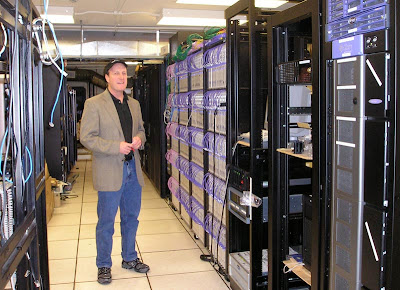 The founders, Mr. Hughes and Ms. Ts’o, are each a remarkable combination of business-person, technical-wizard, and art-lover. Their original art collection includes drawings by great Disney animators, Garth Williams, and Jules Feiffer.
The founders, Mr. Hughes and Ms. Ts’o, are each a remarkable combination of business-person, technical-wizard, and art-lover. Their original art collection includes drawings by great Disney animators, Garth Williams, and Jules Feiffer. They have clearly worked hard to attract and keep some of the best talent in the industry. Stacy Burstin, our host, travels to art schools and software conventions to recruit top talent. Animators are allowed to bring their dogs to work, so many of the cubicles have child gates with a canine companion at the artists’ feet.
They have clearly worked hard to attract and keep some of the best talent in the industry. Stacy Burstin, our host, travels to art schools and software conventions to recruit top talent. Animators are allowed to bring their dogs to work, so many of the cubicles have child gates with a canine companion at the artists’ feet. After seeing a collection of gorgeous original production paintings and sculpted maquettes, I was a little disappointed to learn that both the painting and the sculpting have all gone digital, and physical sculptures of the characters are no longer necessary. But that seems to be true at all the movie houses we visited.
After seeing a collection of gorgeous original production paintings and sculpted maquettes, I was a little disappointed to learn that both the painting and the sculpting have all gone digital, and physical sculptures of the characters are no longer necessary. But that seems to be true at all the movie houses we visited.
It was a real honor to meet so many of the artists and specialists after my Dinotopia presentation, and I congratulate them on their magnificent work.
Blog: Gurney Journey (Login to Add to MyJacketFlap)
JacketFlap tags: road tour, Movie Studios, Add a tag
A cluster of seven unmarked buildings in Culver City is the home of some of the most eye-popping visual effects in the movie business. Sony Imageworks has created visual effects for films like Spiderman 3, Stuart Little, and Starship Troopers.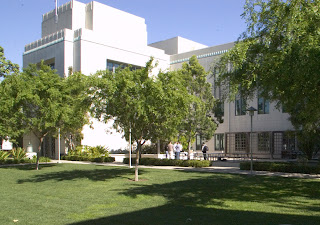 This is also the headquarters of Sony Pictures Animation, one of the major players in the field of CGI animation, who recently created Surf’s Up and Open Season. The animation division was set up starting in 2002 after the success of the ChubbChubbs.
This is also the headquarters of Sony Pictures Animation, one of the major players in the field of CGI animation, who recently created Surf’s Up and Open Season. The animation division was set up starting in 2002 after the success of the ChubbChubbs.
As a fee-for-service post-production FX company, Sony does straight 2-D visual effects and 3-D character work, the latter including such tasks as creating a virtual Toby McGuire as a stand in for the real actor when he’s called upon to do dangerous stunts. Sony has also been a pioneer in the controversial technique of motion capture, or as they call it “performance capture” in such films as Polar Express and Beowulf, developing a new art form that bridges the boundary between live action and animation.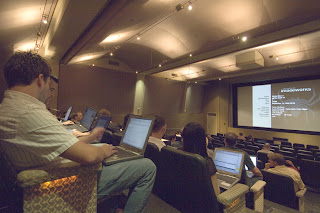 Sony Pictures Animation, or “SPA,” as it is known here, has its own in-house visual development department, which hammers out the story and crafts the look of the characters and environments. The rigging, animation, surfacing and lighting are then handled by the Imageworks team next door. Their artists have to cover the gamut from photo-real live action effects to the caricatured world of CGI animation. The huge demands on the computers to render all this material requires 4000 processors, and up to a petabyte of memory.
Sony Pictures Animation, or “SPA,” as it is known here, has its own in-house visual development department, which hammers out the story and crafts the look of the characters and environments. The rigging, animation, surfacing and lighting are then handled by the Imageworks team next door. Their artists have to cover the gamut from photo-real live action effects to the caricatured world of CGI animation. The huge demands on the computers to render all this material requires 4000 processors, and up to a petabyte of memory.The talent pool thus ranges from artist/designers to software specialists. We toured both facilities before and after my presentation, and I had a chance to meet SPA’s visual development legends like Richard Chavez, Luc Desmarchelier, and Ron Lukas, who, along with Paul Lasaine, are busy creating environments and characters for a variety of new shows in development.
The visual effects team has developed sophisticated tools to create photo-real water, fire, and fabric, all of which has been a challenge to model convincingly in CG. For Surf’s Up, they not only had to create realistic breaking waves, but set up a control system so they could curl and crash on cue. In-house software engineers have developed proprietary tools for fur and fabric. “Cloth has come a long way, too,” said our host Steve Prawat.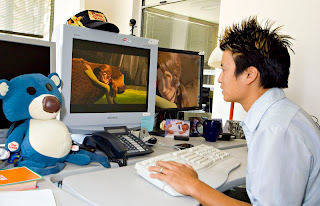 Sande Scoredos, the director of training and artistic development, said that new hires spend two weeks in training, with a whole regimen of classes. They’re given a practice shot to animate, basically a digital puppet figure in a virtual room, and if they can meet the requirements, they get “crewed.”
Sande Scoredos, the director of training and artistic development, said that new hires spend two weeks in training, with a whole regimen of classes. They’re given a practice shot to animate, basically a digital puppet figure in a virtual room, and if they can meet the requirements, they get “crewed.”
Like all CGI animation companies, Sony works hard to keep its 900-1400 artists happy and learning. They offer free classes in life drawing and acting, bring in live falcons, take trips to art museums, and present lectures by cinematographers, classic animators like Chuck Jones—and author/illustrators like me. “We have a program in place for people who want to go up the career path,” said Mr. Prawat.As I signed the artist wall, I felt honored to be a guest at a studio with such a respected artistic legacy. It’s an exciting career indeed for young artists to consider.
Some images provided by Sony Imageworks.
Blog: Gurney Journey (Login to Add to MyJacketFlap)
JacketFlap tags: Watercolor Painting, Movie Studios, Art Schools, Add a tag
It's been a flurry of visits to art schools and movie studios over the last two weeks. I'm way behind on the blog!
We started off by giving the presentation at Rhythm & Hues, DreamWorks Animation, LA Public Library, Sony Pictures Animation and Imageworks in southern California.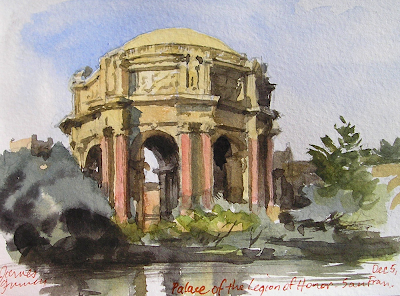 Then in northern California we've had the privilege of visiting PDI DreamWorks and Academy of Art University. Today we went to Industrial Light and Magic in the Presidio region of San Francisco. We arrived early with an hour to kill, so we both did watercolor sketches of the Palace of Fine Arts, a remnant of the 1915 Pan-Pacific Exposition.
Then in northern California we've had the privilege of visiting PDI DreamWorks and Academy of Art University. Today we went to Industrial Light and Magic in the Presidio region of San Francisco. We arrived early with an hour to kill, so we both did watercolor sketches of the Palace of Fine Arts, a remnant of the 1915 Pan-Pacific Exposition.Then we entered the ILM complex. We blithely passed beyond guards, gates, cameras, flashing red lights, magnetic barriers, and a gurgling fountain surmounted by a bronze Yoda. I felt a little like Luke entering the Death Star. We set up the laptop in a cavernous state-of-the-art theater, and soon artists started arriving for the talk.
It was an honor to meet so many ILM legends, like Erik Tiemens, Carlos Huante, Darin Hilton, and many more whose work I greatly admire. Thanks to our host Josh Kushins (below with our folding hand truck), and to everyone who attended. And for those of you blog readers who are art students, ILM is an amazing place to work, justly famous for its Oscar-winning legacy, its spirit of innovation, its vast talent pool of about 1200 professionals, and its spectacular location.And I haven't even mentioned the bookstores: Storyopolis, Linden Tree, Booksmith, and Cody's, where I got to meet Austin Madison from Pixar.
The full report on all the other studios and schools will have to wait a while until we catch up. Tomorrow: San Jose State!
Blog: Gurney Journey (Login to Add to MyJacketFlap)
JacketFlap tags: Movie Studios, Plein Air Painting, Add a tag
Christopher Evans headed up the matte painting department at Lucasfilm during Return of the Jedi. He later rendered dozens of computer-generated illusions for Matte World Digital. But it was always his dream to have a one-man show of his oil paintings at a top gallery in New York City.
Yesterday Jeanette and I arrived from the pouring rain for the unveiling of “Open Space,” an exhibition of a dozen large landscape panoramas at the Fischbach Gallery in Chelsea. Mr. Evans’s mastery of light, air, and atmosphere were in full display here, with fleecy cumulus cloud forms and rolling California hillsides stepping back into luminous distances.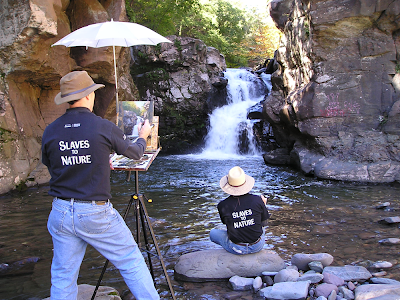
Mr. Evans, it may be revealed, is a founding member of the Slaves to Nature, seen here painting Fawn’s Leap along Kaaterskill Creek. I was working behind him in what appears here to be a tranquil section of the stream, little suspecting that disaster was about to strike. But that’s another story for another post.



james is it intimidating going to the biggest art studios and schools all across the united states? i can remember how intimidated i was just in painting class with a group of other great artists. i cant imagine what it might be like going to see and present infront of the best students and artist working in the united states every week, and somtimes twice a week or more. thats nuts!
by the way how did this tour form. it seemed like it was a tour to start off the new book. but now seems to be going in the direction of schools and huge art studios?
did you plan to tour these studios and schools and why did you choose studios and schools to present the new book. instead of the regular museams and bookstores?
hope i'm not being nosey. just very curious and jealous!
thanks
e
Good questions, Big E, and I should explain:
The Chandara tour has been a very different kind of tour, because I organized it, not some disinterested publicist. Lecture fees and book sales funded the transportation and food expenses of the trip, while the publisher generously agreed to pay for hotels.
I chose art schools because I was curious how art is being taught these days, and I chose movie studios because I knew that some of the most gifted artists work at those places.
For some reason I don't feel intimidated by being around incredibly good artists--I just feel lifted up by talking to them and seeing their work.
I loved working at DreamWorks, and it wasn't just the 30lbs I gained there (ha! No freshman 15 at my current job at Google). What both companies have in common is a sense of providing a kind, productive atmosphere for professionals in their fields.
Well, we were absolutely thrilled to have you visit and I have to say to Big E that if there was any intimidation it went the other way around.
Yes, the free food at Dreamworks is fantastic but you should've seen it when the studio opened it's doors a decade ago. To draw talent and goodwill the food was utterly lavish with fresh baked desserts everyday at 3 and a freezer always full of Haagen Dazs bars. I honest to goodness quit eating dinner, having filled my calorie requirements before I got home.
I appreciated the industrial sketch having spent many lunchtimes sketching in that area. You might enjoy the blog of Mike Hernandez one of our art directors. If you go into his archives, he has some of the most beautiful industrial sketches I've seen. http://mikehernandez.blogspot.com/
Thanks again and Happy Holidays!!